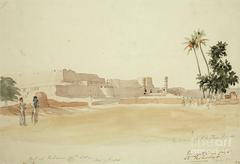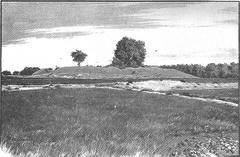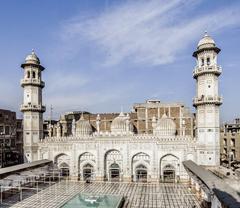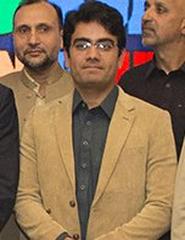Cunningham Clock Tower Peshawar: Visiting Hours, Tickets, and Historical Significance
Date: 04/07/2025
Introduction
The Cunningham Clock Tower, locally known as “Ghanta Ghar,” stands as a prominent landmark in the heart of Peshawar, Pakistan. Erected in 1900 to commemorate Queen Victoria’s Diamond Jubilee, the tower embodies the city’s rich colonial past and vibrant present. Blending British Victorian Gothic and Mughal architectural influences, it serves not only as a historical monument but also as a social and cultural hub. This comprehensive guide provides detailed information on visiting hours, ticketing (free entry), accessibility, architectural significance, nearby attractions, and practical travel tips to ensure a rewarding visit. Whether you are an architecture enthusiast, history buff, or cultural explorer, the Cunningham Clock Tower offers a window into Peshawar’s layered heritage (Youlin Magazine; Wikipedia; TravelSetu).
Table of Contents
- History and Origins
- Architectural Features
- Visiting Hours and Ticket Information
- Accessibility and Travel Tips
- Nearby Attractions
- Preservation and Restoration
- Cultural and Social Significance
- Visitor Experience
- FAQs
- Conclusion
- References and Further Reading
History and Origins
The Cunningham Clock Tower was constructed at the turn of the 20th century to commemorate Queen Victoria’s 60-year reign over the British Empire. The foundation stone was laid in 1898, and the tower was completed in 1900 (Wikipedia). Named after Sir George Cunningham, Lieutenant Governor of the North-West Frontier Province, the tower also reflects the complexities of colonial administration, with some sources attributing the name to Sir Alexander Frederick Douglas Cunningham (Pineqone; Trek Zone). The tower was funded by the Balmukand family, prominent local philanthropists.
Strategically located at the crossroads of Saddar and Circular Roads in Saddar Bazaar, the tower became a symbol of technological progress through its public clock and bell, introducing standardized timekeeping to the city (Visit Silk Road). It has since witnessed pivotal moments in the city’s history, from the colonial era through Partition and into modern nationhood (Travel Pakistani).
Architectural Features
The Cunningham Clock Tower is a striking example of colonial-era architecture, designed by James Strachan, the British Municipal Engineer of Peshawar (Youlin Magazine). Measuring approximately 85 feet (26 meters) in height, the tower exhibits a square base, a tapering shaft, and a domed cupola.
Key elements include:
- Materials: Locally sourced brick and stone ensure both durability and a connection to local craftsmanship.
- Design: Four clock faces, each imported from England, are visible from all directions. The original clock mechanism and iron bell, though less frequently chimes today, remain integral to its character (discover-country.com).
- Facades: The tower’s Victorian Gothic styling is evident in pointed arches, pilasters, and ornamental moldings. The domed cupola and geometric patterns reflect Mughal influences.
- Inscriptions: Marble plaques in English and Urdu at the base commemorate Queen Victoria’s Diamond Jubilee and the tower’s completion in 1900.
The tower’s architectural grandeur is complemented by slender turrets, narrow arched windows, and ornamental detailing, making it a favorite subject for photographers and architecture enthusiasts (evendo.com).
Visiting Hours and Ticket Information
- Accessibility: The tower is an open-air monument and can be visited at any time. For safety and the best experience, daylight hours—typically from 8:00 AM to 6:00 PM—are recommended.
- Entry Fee: There is no charge to visit or photograph the tower’s exterior.
- Guided Tours: While official tours of the interior are not available, local heritage tours often include the tower as a key stop (Apricot Tours).
Accessibility and Travel Tips
- Location: Central in Saddar Bazaar, the tower is easily accessible by private vehicles, taxis, rickshaws, and local buses. The nearby Peshawar BRT station and the Peshawar Cantonment Railway Station are within walking distance (Pakistan Tour & Travel).
- Pedestrian Access: Wide pavements and crosswalks are present, but visitors should be cautious due to busy traffic.
- For Differently-Abled Visitors: Some areas around the tower have uneven surfaces and limited ramps. Visiting during off-peak hours is recommended for those with mobility challenges.
- Travel Tips: Dress modestly in accordance with local customs, remain alert in crowded areas, and secure valuables. Early morning and late afternoon visits offer the best light for photography (Laure Wanders).
Nearby Attractions
The tower’s central location makes it an excellent starting point for exploring Peshawar’s rich heritage trail:
- Saddar Bazaar: Vibrant market for handicrafts, textiles, and street food.
- Qissa Khawani Bazaar: Known as the “Storytellers’ Market,” famous for its traditional tea houses.
- Sethi Houses: Ornate 19th-century mansions showcasing unique woodwork.
- Bala Hisar Fort: Offers panoramic city views and a military history museum.
- Peshawar Museum: Home to Gandharan Buddhist artifacts and Islamic art.
- Mahabat Khan Mosque: Renowned 17th-century mosque with a marble façade.
For a complete list of attractions, consult the Khyber Pakhtunkhwa Tourism Department.
Preservation and Restoration
The tower has undergone several restoration projects, most notably in 2003, to address structural wear and maintain its historical character. Efforts led by local authorities and heritage organizations include:
- Structural Repairs: Reinforcement of brickwork and restoration of the clock mechanism.
- Beautification Projects: Improved lighting, landscaping, and installation of informational plaques.
- Community Engagement: Awareness campaigns to foster local appreciation and protect the site from urban encroachment and pollution (faqs.com.pk).
Ongoing challenges include pollution, banner placements, and traffic congestion. Future plans focus on enhanced seismic protection, restoration of original mechanisms, and the creation of a pedestrian plaza.
Cultural and Social Significance
More than just a monument, the Cunningham Clock Tower is woven into Peshawar’s collective memory and daily life (TravelSetu). It serves as:
- A Social Hub: Popular meeting point for locals and tourists, surrounded by lively markets, food stalls, and artisan shops.
- A Venue for Civic Events: The tower has witnessed public celebrations, protests, and cultural festivals throughout its history (Tribune).
- A Navigational Anchor: Its visibility makes it a key reference point in city navigation and heritage trails.
- A Symbol of Urban Identity: Representing resilience and continuity amid political and social changes.
The tower’s presence enriches the urban fabric and provides a tangible link to Peshawar’s colonial legacy and multicultural heritage.
Visitor Experience
- Photographic Opportunities: The tower’s design and bustling surroundings are ideal for photography, particularly during the golden hours of sunrise and sunset.
- Cultural Immersion: Engage with local vendors, sample traditional delicacies, and experience the city’s street life.
- Safety: While generally safe, it is advisable to avoid displaying valuables and to be vigilant in crowded areas.
- Dress Code: Modest attire is recommended, especially for women; headscarves and loose clothing are appropriate (Laure Wanders).
FAQs
Q: What are the Cunningham Clock Tower visiting hours?
A: The tower is accessible 24/7, but visiting during daylight (8:00 AM–6:00 PM) is recommended for safety and optimal experience.
Q: Is there an entry fee?
A: No, visiting the tower’s exterior is free of charge.
Q: Are guided tours available?
A: While there are no official interior tours, local heritage tours often include the tower.
Q: How can I reach the tower by public transport?
A: The tower is accessible via local buses, rickshaws, and the Peshawar BRT system, with a station at Saddar Bazaar.
Q: Is the site accessible for visitors with disabilities?
A: Some limitations exist due to uneven surfaces and crowds; visiting during less busy times is advised.
Q: Can I take photographs?
A: Yes, photography of the exterior and surrounding markets is encouraged.
Q: What are the best nearby attractions?
A: Qissa Khawani Bazaar, Sethi Houses, Bala Hisar Fort, Peshawar Museum, and Mahabat Khan Mosque.
Conclusion
The Cunningham Clock Tower is more than a relic of Peshawar’s colonial past—it is a living emblem of the city’s evolving identity and cultural vibrancy. Its architectural beauty, historical depth, and central location make it an essential destination for visitors. Ongoing preservation efforts and community engagement highlight the importance of safeguarding this monument for future generations. Plan your visit to experience the unique blend of history, architecture, and local life that the Cunningham Clock Tower offers at the heart of Peshawar.
For the most current information on visiting hours, preservation initiatives, and events, consult the Khyber Pakhtunkhwa Tourism Department.
References and Further Reading
- Youlin Magazine – Gantha Ghar: The Historic Clock Tower of Peshawar
- Wikipedia – Cunningham Clock Tower
- Discover Country – Sir Cunningham Clock Tower
- TravelSetu – Things to Do in Peshawar
- Pakistan Tour & Travel – Famous Places in Peshawar
- Apricot Tours – Places to Visit in Peshawar at Night
- Khyber Pakhtunkhwa Tourism Department
- Trek Zone – Cunningham Clock Tower
- Pineqone – Attractions: Cunningham Clock Tower
- Visit Silk Road – Sir Cunningham Clock Tower
- Travel Pakistani – Ghanta Ghar: Famous Historical Site of Peshawar
- Laure Wanders – Places to Visit in Peshawar
- faqs.com.pk – Ghanta Ghar and Cunningham Clock Tower
- evendo.com – Sir Cunningham Clock Tower
- pk.worldorgs.com – Sir Cunningham Clock Tower
- Tribune – Ticking Away: The Tower That Stood the Test of Time
For itinerary planning, download the Audiala app for real-time updates, guided tours, and exclusive insights. Share your experiences using #PeshawarHeritage on social media.




